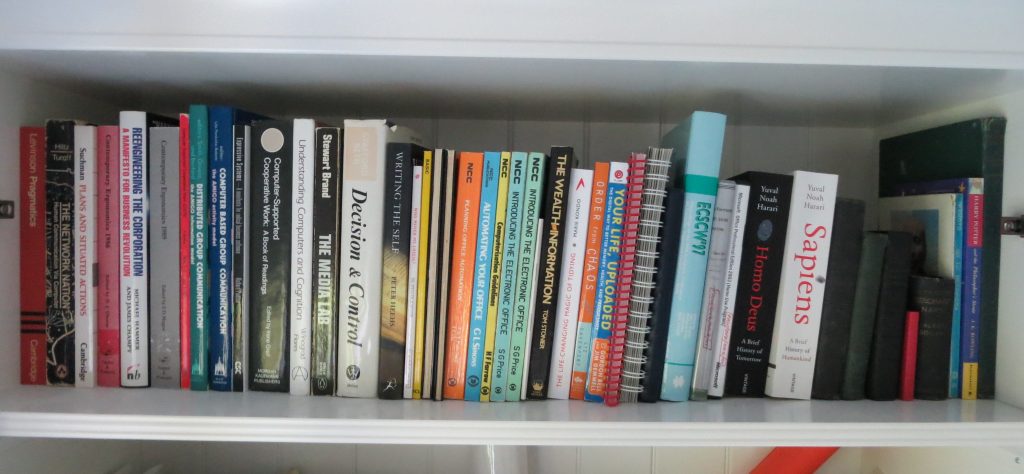The primary objects to be addressed in this journey are the books and other items on the topmost shelf in the cabinet in my study, as shown in the photo below.
 To get started, I made a quick assessment of what each item means to me by looking at the spines in the photos and writing brief notes in scrawly longhand in my Journeys notebook – somehow, electronic media just can’t replicate the freedom and unconstrained nature of the longhand scrawl. Although this exercise stimulated a good selection of musings, it also made me think that there are probably several different points of view from which a book can be considered and that each of those points of view might stimulate different thoughts. For example, I have a general awareness that the bookshelf contains a set of work books that I don’t look at very often; and I’m aware of that bookshelf in the context of all the other bookshelves I have and of the availability or shortage of space across all of them. When I take a closer look at the bookshelf I recognise specific books; and sometimes when I muse on one of them, thoughts pop into my head about it, including why I have decided to keep it. Finally, if I actually take a book off the bookshelf and handle it and leaf through some of the pages, I experience further thoughts; and, sometimes, the smell of a book might stimulate a memory. To try to be as methodical as possible, these different points of view have been given the following names:
To get started, I made a quick assessment of what each item means to me by looking at the spines in the photos and writing brief notes in scrawly longhand in my Journeys notebook – somehow, electronic media just can’t replicate the freedom and unconstrained nature of the longhand scrawl. Although this exercise stimulated a good selection of musings, it also made me think that there are probably several different points of view from which a book can be considered and that each of those points of view might stimulate different thoughts. For example, I have a general awareness that the bookshelf contains a set of work books that I don’t look at very often; and I’m aware of that bookshelf in the context of all the other bookshelves I have and of the availability or shortage of space across all of them. When I take a closer look at the bookshelf I recognise specific books; and sometimes when I muse on one of them, thoughts pop into my head about it, including why I have decided to keep it. Finally, if I actually take a book off the bookshelf and handle it and leaf through some of the pages, I experience further thoughts; and, sometimes, the smell of a book might stimulate a memory. To try to be as methodical as possible, these different points of view have been given the following names:
Presence: Awareness of book/s or types of book/s in a particular location.
Space: Awareness of the type, suitability and availability of storage space the book(s) is/are in and the way they are being stored in the space.
Recognition: A consciousness of the Title/Author of a particular book and possibly of what the book is about.
Reason for Keeping: Why this particular book was retained during prior clear outs.
Sight Stimulation: The emergence of thoughts and memories related to a particular book stimulated by looking at the outside of the book (and possibly just the spine).
Handling Stimulation: The emergence of thoughts and memories related to a particular book stimulated by touching the book, opening it and leafing through the pages.
Smell Stimulation: The emergence of thoughts and memories related to a particular book stimulated by the smell of the book.
The first two (Presence and Space) apply to my awareness of the bookshelf as a whole and generated the following thoughts:
Presence (top shelf): Retained work books and some other books on the top shelf of the white cabinet
Space (top shelf): The shelf is full and I’ve run out of shelf space in the whole of my study. I could do with freeing up some shelf space or getting some more shelving.
The remaining points of view were considered with respect to each individual item on the bookshelf in turn. For Sight Stimulation and Handling Stimulation there was no limit placed on the number of separate thoughts that could be recorded. The detailed results are shown in this analysis spreadsheet (note that the Smell Stimulation yielded almost no results – possibly due to a blocked nose, but maybe an indication that this type of stimulation occurs only rarely). The thoughts that were stimulated were then sorted into a two level categorisation. The top level categories are:
Topic, Publisher, Author, Acquisition, Use, Value, People, Events, Places, Experiences, Father, Borrowed, Physical characteristics, Spine, Scanning decision, Not applicable to this exercise.
The lower level categories and their frequency of occurrence are documented in this Types of Thoughts spreadsheet.
With this basic analysis work completed, the next step will be to ask the following question of each item on the shelf: “What would have to be displayed on an electronic story board to make me be prepared to destroy the item in the course of scanning it?”. I shall provide answers while reviewing the thoughts I have recorded for each item.
